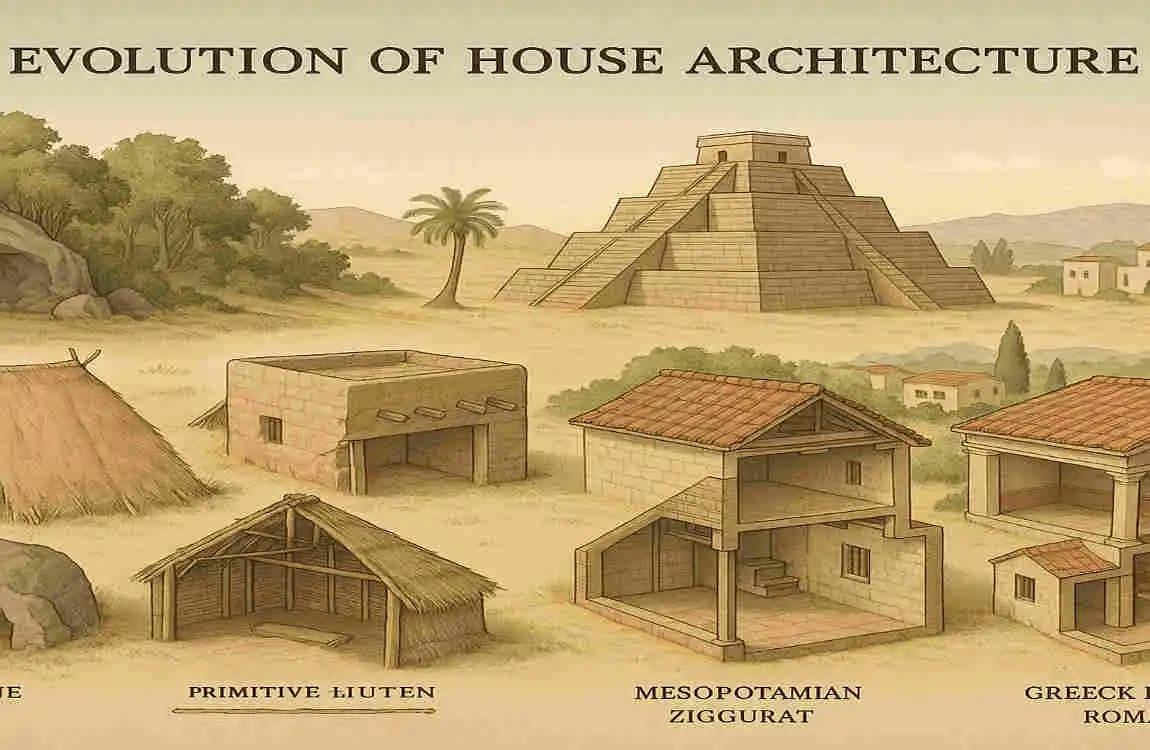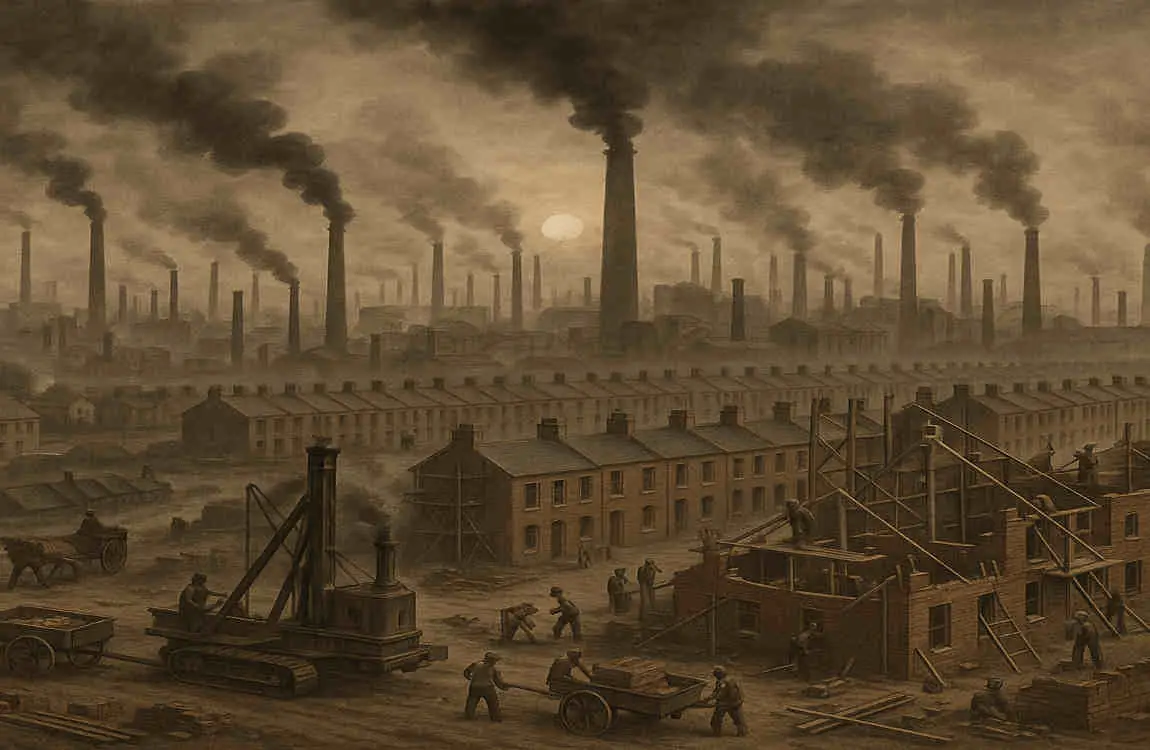Have you ever looked at your home and wondered how it got to be this way? House architecture isn’t just about bricks and beams—it’s a mirror of human history, reflecting our needs, inventions, and dreams. From simple caves to high-tech smart homes, how has house architecture changed over time? Understanding this evolution helps homeowners like you make more intelligent choices, inspires architects to innovate, and lets enthusiasts appreciate the stories behind every wall.
Origins of House Architecture: From Prehistoric Shelters to Ancient Civilizations

Imagine our ancestors thousands of years ago, huddled in caves or makeshift huts. That’s where the story of house architecture begins. Early humans didn’t have blueprints or power tools—they built what they could to survive harsh weather and wild animals. Think about it: a simple shelter made from branches, leaves, or animal skins was a big deal back then.
These primitive homes adapted to their surroundings. In cold areas, people dug into the ground for warmth. In forests, wood became the go-to material. This flexibility shows how house architecture has changed over time, even in the earliest days, driven by survival needs.
The Dawn of Permanent Structures
As humans settled down, shelters got more permanent. Around 10,000 BCE, during the Neolithic period, people started farming and needed stable homes. They used mud, stones, and thatch to create huts that lasted longer. These weren’t just roofs over heads—they included spaces for cooking, sleeping, and storing food.
Picture a round hut with a thatched roof. It kept rain out and warmth in. Early innovations like this laid the groundwork for what we’d call “design.” People began thinking about comfort, not just protection.
Ancient Civilizations and Their Lasting Impact
Fast forward to ancient civilizations, and things get exciting. In Mesopotamia, around 4000 BCE, folks built with sun-dried mud bricks. These homes had flat roofs and courtyards for airflow in hot climates. Egyptians took it further with stone masonry for grander structures, like homes along the Nile that resisted floods.
Don’t forget the Indus Valley—their cities had brick houses with plumbing! Yes, early bathrooms. In ancient China, wooden frames and tiled roofs created homes that withstood earthquakes. Fundamental symmetry emerged here, making spaces feel balanced and welcoming.
These examples highlight how house architecture has changed over time from crude shelters to organized designs. Key elements like mud bricks and stone work became building blocks for future styles. If you’re into history, visiting sites like these (or even virtual tours) can make it real—have you ever explored an ancient ruin?
Classical to Medieval Architecture: The Age of Fortification and Ornamentation
The classical era brought elegance to homes. Greeks and Romans turned houses into works of art. They used columns, courtyards, and smart proportions to blend beauty with function. A Roman villa, for instance, had open spaces for family life and mosaics on floors for that wow factor.
You may also read (omaze cotswold house location).
Greeks focused on harmony—think Doric columns supporting simple, sturdy roofs. Romans added luxury, like heated floors via underfloor systems. This era showed how house architecture has changed over time by prioritizing aesthetics alongside practicality.
Shifting to Medieval Times
As empires fell, the Middle Ages kicked in around the 5th century. Safety became key. With wars and invasions, people fortified their homes. Castles weren’t just for kings—they influenced manor houses with thick walls and moats.
Peasant homes stayed simple: thatched roofs, dirt floors, and one-room setups. But even these had clever touches, like central hearths for heat. Social needs shaped designs—feudal lords built grand halls for gatherings, while religion inspired chapels in homes.
Gothic and Tudor Twists
The Gothic Style emerged in the 12th century. Pointed arches let buildings soar higher, and stained glass windows added color and light. Homes felt more uplifting, less gloomy.
Tudor architecture in England brought timber framing and steep roofs. These styles reflected a mix of defense and decoration. Architectural styles over time evolved here due to feudalism—wealthy folks showed off with ornate details, while others focused on basics. What do you think: Would you want a fortified home today, or something more open?
Renaissance and Baroque Periods: Revival and Extravagance
The Renaissance, starting in the 14th century, was like a fresh start. It revived classical ideas from Greece and Rome. Symmetry, balance, and proportion ruled. Homes became expressions of humanism—people wanted spaces that felt harmonious and inspiring.
Italian villas popped up with formal gardens and grand entrances. Architects like Palladio used orders like Doric and Ionic columns to add class. This shift marked how house architecture has changed over time toward personal expression.
The Baroque Boom
By the 17th century, the Baroque Style amped up the drama. Think curving lines, gold accents, and theatrical flair. French chateaus and Spanish mansions went all out with ornate facades and lavish interiors.
These homes reflected social aspirations—royalty and the rich wanted to impress. Baroque added emotion to architecture, moving away from the Renaissance calm. Cultural shifts, like the Age of Exploration, brought new ideas and materials, influencing designs worldwide.
Imagine living in a Baroque palace—extravagant, right? But it shows how homes mirrored society’s love for grandeur.
Industrial Revolution: Mass Production and New Materials Transform Housing

The 18th and 19th centuries flipped everything with the Industrial Revolution. Factories churned out materials like cast iron, steel, and glass. Suddenly, building homes got faster and cheaper.
Workers’ homes were basic terraced houses in cities, packed tightly for urban growth. But the wealthy enjoyed Victorian styles—ornate with bay windows and intricate ironwork. This era introduced multi-story buildings, changing skylines forever.
Reactions and Innovations
Not everyone loved the factory feel. The Arts and Crafts movement pushed back, emphasizing handmade quality and natural forms. Art Nouveau followed with flowing, plant-inspired designs.
You may also read (what are the future trends in home technology).
Big game-changers? Plumbing, central heating, and electricity. Homes got comfier—indoor toilets and lights! Changes in home construction here were massive, driven by tech. Urbanization meant more apartments, reshaping family life. How has this affected your own home setup?
To break it down, here’s a quick list of key innovations from this period:
- Steel frames: Allowed taller, stronger buildings.
- Mass-produced bricks: Made housing affordable for the masses.
- Glass panes: Bigger windows for natural light.
20th Century to Present: Modernism, Sustainability, and Smart Homes
The 20th century brought modernism—think clean lines, open plans, and function first. Architects like Le Corbusier used concrete, steel, and glass for minimalist homes. No more frills; it was about efficiency.
Post-World War II, suburbs boomed with cookie-cutter houses. Mid-century modern added flair with flat roofs, oversized windows, and indoor-outdoor flow. Evolution of residential design sped up here, adapting to cars and families.
Today’s Trends
Now, sustainability rules. Eco-friendly materials like recycled wood and solar panels make homes greener. Smart tech integrates—think voice-controlled lights and energy monitors.
Architects blend old and new, preserving heritage while innovating. How has house architecture changed over time? From rigid structures to flexible, tech-savvy spaces that save the planet.
For a visual summary, check this table of modern vs. traditional features:
Feature Traditional (Pre-20th Century)Modern (20th Century Onward)
Materials : Wood, stone, brick , Concrete, steel, glass
Layout: Closed rooms, formal spaces. Open floor plans, flexibility
Sustainability Minimal focus Energy-efficient, eco-materials
Technology Basic (e.g., fireplaces) , Smart systems, automation
This table shows the shift—pretty eye-opening, huh?
Key Factors Influencing Changes in House Architecture Over Time
What drives these changes? Technology tops the list. New materials like reinforced concrete revolutionized designs.
Social and cultural factors play a significant role too. Urbanization crammed people into cities, leading to the construction of apartments. Economic classes shaped styles—rich folks got mansions, others got basics.
Climate matters: Hot areas favor open designs, cold ones need insulation. Globalization mixes it up—Japanese minimalism influences Western homes.
Here’s a bulleted list of influences:
- Tech advances: From bricks to 3D printing.
- Cultural shifts: Reflecting values like sustainability.
- Economic factors: Affordability drives mass housing.
These elements keep architecture evolving. Think about your home—what factors shaped it?
How Has House Architecture Changed Over Time: Summary of Major Transformations
We’ve covered a lot! From prehistoric huts to ancient bricks, classical columns to medieval forts, Renaissance symmetry to Baroque drama, industrial mass builds to modern minimalism.
Key transformations? Houses adapted to needs—protection, status, comfort, efficiency. How has house architecture changed over time? It’s a story of human progress, blending tech with culture.
Looking ahead, expect more AI-integrated, sustainable designs. Past trends hint at flexible, eco-smart futures.
Practical Takeaways for Homeowners and Architecture Enthusiasts
Knowing this history isn’t just trivia—it helps you. Spot styles in your neighborhood and appreciate them more.
When designing or renovating, mix old and new. Add Tudor timber to a modern kitchen for charm. It makes homes sustainable and stylish.
For restorations, understanding evolution guides choices. Preserve original features while updating for today. What historical element would you add to your home?
You may also read (walterboro sc courthouse a landmark of local justice).

